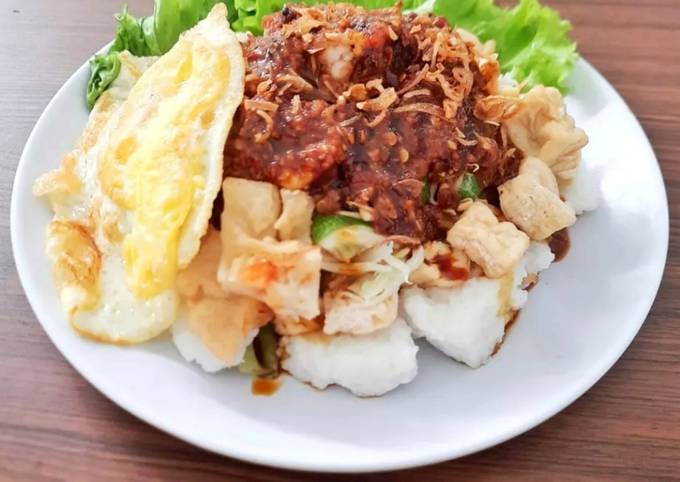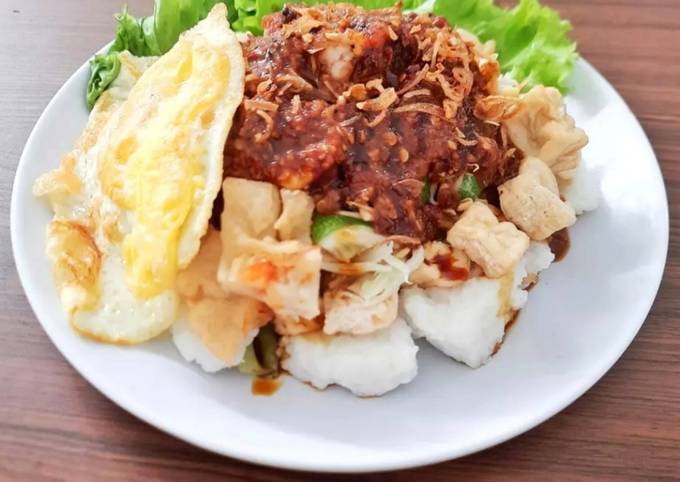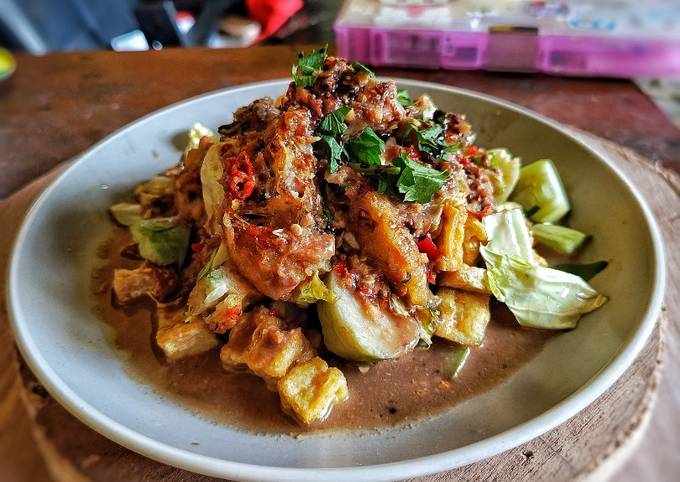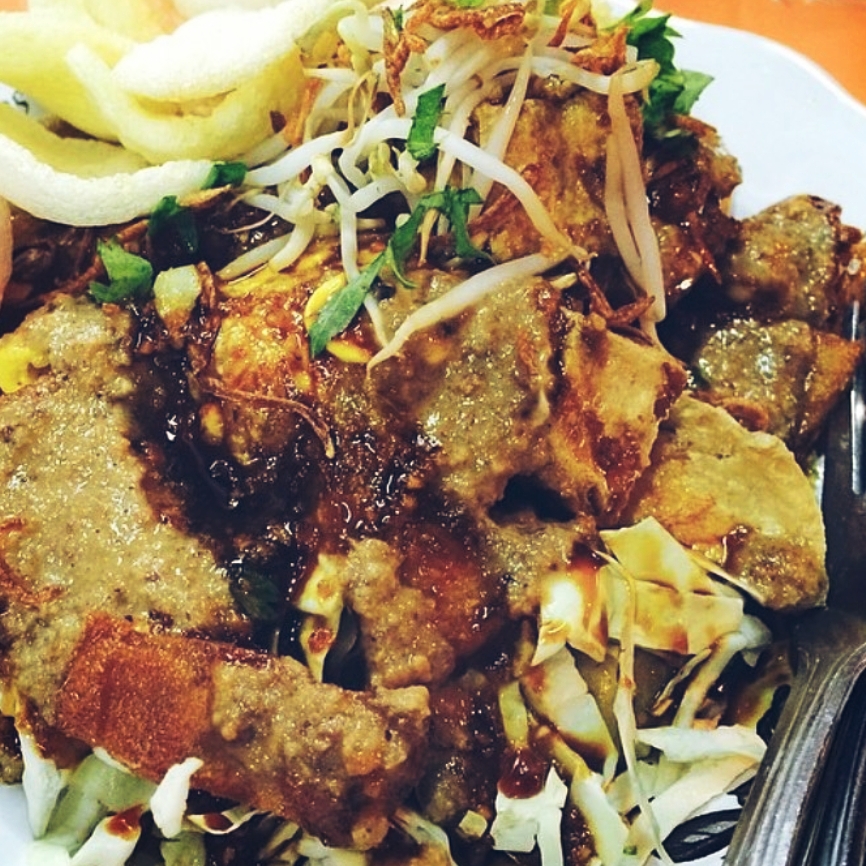
Of course. Here is a 1,200-word article about Tahu Gimbal from Semarang.
Tahu Gimbal: The Savory, Saucy Soul of Semarang
In the rich and diverse tapestry of Indonesian cuisine, certain dishes transcend mere sustenance to become cultural emblems of their city of origin. For Semarang, the bustling port capital of Central Java, that dish is unequivocally Tahu Gimbal. More than just a simple plate of tofu and fritters, Tahu Gimbal is a symphony of textures and flavors—a culinary story that speaks of the city’s history, its coastal character, and its Javanese heart. To understand Semarang is to understand the humble yet profound satisfaction of a perfectly prepared plate of Tahu Gimbal.
At first glance, the dish might appear to be a chaotic yet inviting assembly. A bed of sliced lontong (compressed rice cakes) is layered with fresh, crisp shreds of cabbage and a sprinkle of bean sprouts. On top of this foundation sits the dish’s two namesakes: golden-fried cubes of tofu (tahu) and the magnificent gimbal udang. The entire creation is then lavishly drenched in a thick, dark, and aromatic peanut sauce, finished with a generous scattering of crunchy fried shallots and finely chopped celery. It is a dish that engages all the senses before the first bite is even taken—the aroma of fried garlic and shrimp, the visual contrast of colors and shapes, and the promise of a complex flavor journey.

The Anatomy of a Perfect Plate
To truly appreciate Tahu Gimbal, one must deconstruct its components, for each element is carefully chosen to play a specific role in the final masterpiece.
The Tahu (Tofu): The tofu used is typically a firm, white variety. It is cut into cubes and deep-fried until it achieves a beautiful golden-brown skin while retaining a soft, almost pillowy interior. This textural contrast is crucial; the slight crispness of the exterior gives way to a gentle, yielding center that readily absorbs the flavors of the sauce. It acts as a neutral, comforting base for the more assertive elements of the dish.
The Gimbal Udang (Shrimp Fritter): This is the undisputed star of the show. The word gimbal in the Javanese dialect of Semarang refers to this specific type of fritter. It’s not a delicate, lacy tempura, but a robust, rustic creation. A batter made from flour, rice flour, and a secret blend of spices is studded with whole, small shrimp—shell, head, and all. This is then deep-fried into a craggy, irregularly shaped disc of pure savory delight. A good gimbal is shatteringly crispy on the outside, with a slightly chewy interior where the batter and shrimp have melded. The tiny shrimp provide bursts of oceanic sweetness and a satisfying crunch, making the gimbal the dish’s primary source of texture and umami.
The Lontong and Vegetables: The lontong provides the starchy, carbohydrate foundation, its mild flavor and dense texture a perfect vehicle for the rich sauce. The raw, thinly sliced cabbage and bean sprouts are not mere garnish; they are essential for balance. Their clean, vegetal crunch and watery freshness cut through the richness of the fried components and the heavy sauce, preventing the dish from becoming cloying and adding a vital layer of crispness.

The Soul of the Dish: The Peanut Sauce
If the gimbal is the star, the peanut sauce (bumbu kacang) is the soul. This is where Tahu Gimbal distinguishes itself from other Indonesian dishes featuring peanut sauce, like Gado-Gado or Sate. The sauce for Tahu Gimbal is darker, thicker, and possesses a unique depth of flavor, thanks to one key ingredient: petis udang.
Petis udang is a thick, pungent, dark paste made from fermented shrimp or prawn. It has an intense, funky, and deeply savory flavor that is the secret weapon of many East and Central Javanese dishes. In the Tahu Gimbal sauce, roasted peanuts are ground—often by hand using a traditional stone mortar and pestle (ulekan)—with garlic, red chilies for a hint of heat, and a generous amount of palm sugar for a balancing sweetness. The petis udang is then stirred in, transforming the familiar peanut sauce into something far more complex. It adds an unmistakable umami backbone and a slightly briny, oceanic note that beautifully complements the shrimp in the gimbal. The resulting sauce is a masterful balance of sweet, savory, spicy, and funky—a velvety, all-encompassing blanket that ties every single element on the plate together.
A Taste of History and Culture
The origins of Tahu Gimbal are, like many street foods, not meticulously documented but can be pieced together from the cultural and geographical context of Semarang. As a major port city on Java’s northern coast, Semarang has long been a melting pot of cultures—Javanese, Chinese, Arab, and European. This multiculturalism is reflected in its cuisine.

The use of tofu is a clear nod to Chinese influence, as tofu was introduced to Indonesia by Chinese immigrants centuries ago. The shrimp, central to the gimbal, speaks to Semarang’s identity as a coastal city where seafood is abundant and integral to the local diet. The peanut sauce and lontong, however, are firmly rooted in Javanese culinary tradition. Tahu Gimbal is therefore a perfect microcosm of Semarang itself: a harmonious blend of native Javanese flavors and foreign influences, shaped by its coastal geography. It is a dish born of the people, likely starting as a simple, affordable meal sold from pushcarts (kaki lima) to laborers and locals, gradually evolving into the beloved classic it is today.
The Ritual of Preparation and Consumption
Finding Tahu Gimbal in Semarang is an adventure in itself. While some established restaurants serve it, the most authentic experience is often found at a humble warung (small eatery) or a street-side stall, particularly around the Simpang Lima area or Taman Menteri Supeno, affectionately known as Taman KB.
Here, the preparation is a form of culinary theatre. You’ll see the vendor, often with practiced, almost unconscious efficiency, working in front of you. The sizzle of the tofu and gimbal hitting the hot oil fills the air. The most captivating part of the ritual is often the making of the sauce. Many vendors still grind the sauce to order on a large ulekan. They’ll ask for your preferred spice level—tidak pedas (not spicy), sedang (medium), or pedas (spicy)—and adjust the number of chilies accordingly. The rhythmic sound of the pestle grinding the peanuts, garlic, and chilies is a sign of freshness and tradition.
Once all the components are ready, the assembly is quick. The lontong, tofu, and gimbal are often cut into bite-sized pieces with scissors. The vegetables are added, and then comes the final, glorious act: a ladleful of the freshly made peanut sauce is poured over everything, followed by the final flourish of fried shallots and celery. Served on a simple plate, sometimes lined with a banana leaf for extra aroma, it’s a dish meant to be eaten immediately, while the gimbal is still hot and crispy and the vegetables are still fresh and crunchy.

For the people of Semarang, Tahu Gimbal is more than just a meal. It is comfort food, a taste of home, a source of civic pride. It’s the go-to dish for a casual lunch, a satisfying dinner, or a late-night craving. It’s a food that bridges social classes, enjoyed by everyone from students to business executives. It is, in every sense, the savory, saucy, and utterly irresistible soul of Semarang. To visit the city and not try it is to miss out on its very essence.


About Tahu Gimbal from Semarang. pictures collections gallery
About Tahu Gimbal from Semarang. is a nice pictures and stock photo for your computer desktop or your smartphone device (ipad, tablet, blackberry, iphone, and other device) and also for your personal use. Free available for desktop wallpaper or additional image collections for your all needs. And was uploaded by admit at date July 1, 2025. You can download it in your computer by clicking download button to save image... have nice day and have fun guys..
This 1 image in featured post from 0 Photos/images Gallery and awesome picture selections about About Tahu Gimbal from Semarang. is available to download. "Download & Save" images/pictures/wallpapers now and this Is one of the post that listed in packed to Category is Foods directory, with image dimension/resolution size is 680 × 482 px and size image/picture file is 42 KB with original link post ID is : https://powae.pw/of-course-here-is-a-1200-word-article-about-tahu-gimbal-from-semarang/. Get download/save images in post and gallery, "download" images or "preview" it on a bigger image for spesification sample in Large size (full attachment size) here : [Download & View to Large size]. Just Simple way, in thumbnail or in Gallery. *Click images to view Large Size.We collect this wonderful image from online and choose one of the best for you. Pictures collection that posted here was carefully chosen and published by author after choosing the ones which are best among the others. So, ultimately we make it and here these list of best image for your inspiration and informational reason regarding the About Tahu Gimbal from Semarang. as part of blogsite exclusive updates collection. So, take your time and find the best informations and pictures posted here that suitable with your needs and use it for your own collection and personal use. About Image information: Image has been submitted and You are able to give your opinion as evaluations to our web site value.
Don't forget to comment if you interest with this images, you can share this post to social media like as facebook, twitter, google+, pinterest, stumbleupon, and more. just click social media buttons for share this post About Tahu Gimbal from Semarang. Now. :)
Thanks for your visit, I hope you happy come to opo wae, wis opo wae, and get what you're looking for. And hope sometimes you will come back again here. All you need to do is help us develop by discussing this About Tahu Gimbal from Semarang. if you like it "leave your comment". have fun, Thank you.




